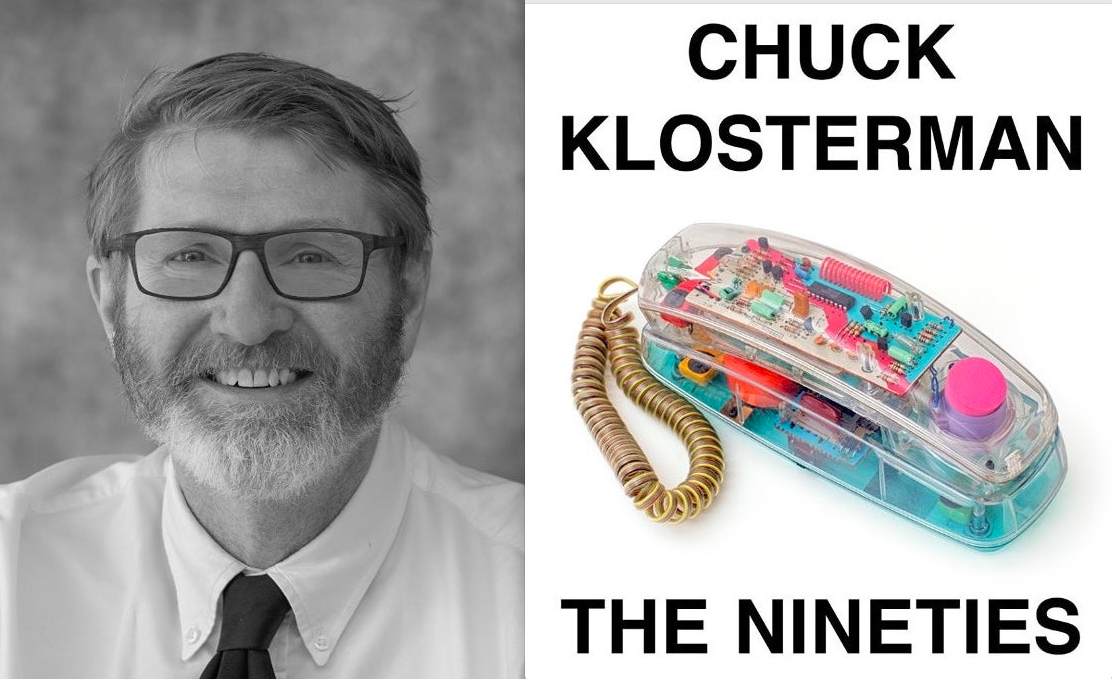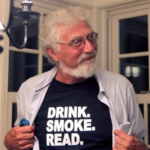1) On the twenty-year gap in generational nostalgia
In the seventies, people lived the fifties, reminiscing over the preordained conclusion that it had been a better time to be alive (Happy Days and Laverne & Shirley on TV, American Graffiti and Grease in movie houses). In the eighties, people fixated on the sixties, and particularly what it meant to have lived through a failed social revolution that now looked inconsistent and antiquated. The pattern is dependable: Every new generation tends to be intrigued by whatever generation existed twenty years earlier. The nineties were no different, except in the way that interest was performed. A fascination with the 1970s was predictable, but not because that era was seen as more wholesome or more political. The appeal was in the conviction that it had been neither.
2) On the bygone importance of answering landline telephones
There are no statistics illustrating how rare it was for someone to ignore a ringing telephone in 1990. This is because such a question would never have been asked (or even pondered). To do so was unthinkable. For one thing, the ring of a conventional rotary telephone was set at 80 decibels, engineered to be audibly noticed in every room of a two-story house. For another, a phone without an answering machine would ring incessantly until the caller gave up. You had to answer the phone in order to stop the phone. But the main reason everyone always answered the telephone was the impossibility of knowing who was on the line. Every ringing phone was, potentially, a life-altering event. It might be a telemarketer, but it also might be a death in the family. It could be your next-door neighbor, but it could also be the governor, and there was only one way to find out. It was a remarkably democratic device: Every incoming call was equally important, until proven otherwise. If a homebound person wanted to avoid a specific conversation, the only solution was to take the phone off the hook and receive no calls whatsoever.
3) On the curious centrality of television in the 1990s
The importance of television throughout the nineties was easy to feel but hard to explain. The art it offered mattered less than the nature of how it worked and the centrality of its dominance. Television had become the way to understand everything, ruling from a position of one-way control that future generations would never consent to or understand. TV programs were not available when the viewer wanted to see them, but only on the day and time they were scheduled. If you needed to go to the bathroom, you waited for the commercial break and did whatever you needed to do in less than three minutes. If you didn’t like what was currently on, the only options were to watch nothing, watch something you didn’t like, or leave the room. Sitcoms were filmed with three cameras (they all looked the same). Dramas had an “A story” and a less important “B story” (they all worked the same). The news was the news: A person behind a desk told you one version of what was happening, and the clips that accompanied the exposition proved that whatever you were told was (more or less) what had happened. It was the internet before the internet, but it wasn’t like the internet at all. You did not search for what you wanted. You were told what you wanted, within the same moment it was received. Television was not the same as life, but the relationship was closer than it had ever been before and would ever be again.
4) On the arbitrariness of renting VCR tapes for entertainment
Renting VCR tapes fostered a culture of aesthetic diversity, to the point of pure randomness. Most available titles were older, so the only source of promotion was the cardboard box the videotape was packaged in. The rental experience was locked within the physical world, and there was no algorithm coercing consumers toward things they were predisposed to enjoy. The most common way to select a movie was to aimlessly meander around the video store, glance at the covers of various boxes, read the cursory plot descriptions on the back of those boxes, and select the most appealing option that happened to be available.
5) On the inevitability of cable news confirming existing biases
What Fox realized on election night in 2000 (when its ratings spiked upward) and what MSNBC came to accept a few years later was something increasingly visible throughout the nineties, but too journalistically depressing to openly embrace: People watch cable news as a form of entertainment, and they don’t want to learn anything that contradicts what they already believe. What they want is information that confirms their preexisting biases, falsely presented through the structure of traditional broadcasting. It had to look like objective journalism, but only if the volume was muted. Moreover, the bias expressed cannot be subtle or unpredictable; partisan audiences want to know what they’re getting before they actually get it. Unless cataclysmic events are actively breaking, the purpose of cable news is emotional reassurance.
6) On the essentialness and irrelevance of landline telephones
It’s easy to argue that a world without cell phones was charming, and easier still to argue that it was inferior. But it was mostly just immutable. Modern people worry about smartphone addiction, despite the fact that landlines exercised much more control over the owner. If you needed to take an important call, you just had to sit in the living room and wait for it. There was no other option. If you didn’t know where someone was, you had to wait until that person wanted to be found. You had to trust people, and they had to trust you. If you made plans over the phone and left the house, those plans could not be changed—everyone had to be where they said they’d be, and everyone had to arrive when they said they’d arrive. Life was more scripted and less fluid, dictated by a machine that would not (and could not) compromise its location. Yet within these fascistic limitations, the machine itself somehow mattered less. It was an appliance, not that different from the dishwasher. The concept of buying a new phone every other year would have seemed as crazy as installing a new toilet every other Thanksgiving. There was nothing exciting or provocative about a telephone. It had no relationship to taste or independence (every member of a household shared the same telephone number). A phone was supposed to serve one concrete function, and it wasn’t even assumed to be particularly reliable.
7) On Generation X anxieties about “selling out”
What made selling out so psychologically vexing was the level of gradation inherent to its principles: It did not simply mean someone was trying to sell something in order to get rich. It meant someone was compromising the values they originally espoused in exchange for something superficial (which was usually money, but not necessarily). This action was particularly bad if the compromised person was still doing the same work they’d done before, except now packaging that work in an attempt to make it palatable to a less discriminating audience. Since the intent mattered more than the result, the success of the attempt was almost irrelevant—selling out and failing was no better or worse than selling out and succeeding.
8) On Nirvana’s “Nevermind” as the symbolic end of rock
Rock music had reached its logical conclusion—not as a genre, but as the pivotal force propelling youth culture. There would be hundreds of consequential rock albums recorded in the wake of Nevermind, yet none would approach its nonmusical importance. The dominance of Nirvana’s paradoxical aesthetic ended the dominance of rock as an ideology. But it would take fifteen years for most people to detect this.
9) On Nirvana’s in-baked contempt for its own mainstream audience
Throughout the form’s existence, there were always truculent artists who positioned themselves against whatever was considered most obviously popular (Lou Reed thought the Beatles were “garbage,” the Clash said Led Zeppelin made them want to puke, etc.). Nirvana adopted and internalized that perspective. They believed (or at least expressed the belief) that the hunger for mass fame—and particularly what an artist was required to do in order to satiate that hunger—was moronic and humiliating. Yet circumstance forced them to bemoan this experience at the same time they experienced it. The second track on Nevermind, “In Bloom,” directly anticipates how much Cobain will dislike all the thoughtless, antipunk audiences who will inevitably love his album. The song was written and recorded long before those thoughtless antipunk audiences even had a chance to hear it.
10) On the odd fact that Garth Brooks never became an 1990s icon
What’s curious, however, is how rarely Brooks is identified as an iconic nineties figure. His first album came out in spring of 1989, and he announced his (temporary, five-year) retirement in the fall of 2000. The nucleus of his career falls precisely within the decade’s parameters. There’s no misunderstanding about his dominance throughout this period (it sometimes seems like the main thing people know about him), and there’s no better illustration of country’s evolution into a surrogate for a worldview once defined by stadium rock: Though Garth’s modernized version of honky-tonk was most musically reminiscent of George Strait, his live show was influenced by Kiss and his songcraft aspired to Billy Joel (two artists Brooks covered and often referenced). Brooks’s relative lack of historical clout does not compute. Yet it’s possible that this future disregard was already presupposed at the height of his success, which illogically propelled him farther.
11) On the counterintuitive touristic vibe of the TV show “Cops”
There was an ancillary aspect to Cops that played an underrated role in its watchability: the uniqueness of its geography. Cops was filmed in multiple cities across multiple states, and since the sole focus was on criminal activity, it ended up featuring neighborhoods and communities that would never appear on TV for any other reason. It’s possible to argue that Cops was a soft form of fascism, but that it was also an unorthodox form of tourism.
12) On the inevitable emotional failure of sequels to “Star Wars” trilogy
The pop culture lionized by young adults of the nineties was often based on a myth: the dogmatic belief that things they’d loved as children had always been appreciated with adult minds. There was a misguided notion that the populist esoterica of the seventies that had come to signify kitschy subversion—the daredevil Evel Knievel, the sitcom Good Times, the pop band ABBA—had always been seen and experienced in the same way they were now being recalled in retrospect. To classify this as simple “nostalgia” isn’t quite accurate, because the process was proactive and methodical; the goal, it seemed, was to increase the intellectual value of bygone consumer art in order to make it match the emotional resonance that had been there all along. There is no better example of this than the original 1977 Star Wars. So much time and effort had been invested in the Star Wars obsession that the film was mentally reimagined as something it never was: a movie about human emotion, made for adult humans. When The Phantom Menace finally arrived, people who’d been ten years old in 1977 were now thirty-two. And what those thirty-two-year-olds saw was a slow retread of the original film, loaded with computerized special effects that were more sophisticated but less revelatory. The movie was not good. That, however, was not the problem. The problem was that The Phantom Menace forced people to realize they’d been betrayed by the falseness of their own constructed memories.
13) On the final era of traditional, one-way news media
All of the twenty-first century is lumped into the Internet Age, but most of 2001 was still the twentieth century in spirit. Daily newspaper circulation that year was 55.6 million, a statistic similar to the circulation figures from forty years prior. That number would be cut in half over the next twenty years. In 2001, the nightly world news on the three major networks still combined for a rating of 23.4, equating to 33 million viewers (a nightly viewership greater than the audience for the 2020 Academy Awards). The structure of journalism wasn’t that different from how it had worked in the 1960s, and it shaped a much different model for the delivery of information. Time was not elastic. Data was delivered in autonomous chunks. The news cycle was rigid and predictable. The size and content of a newspaper was dictated by the number of advertisements that newspaper had sold in advance. The amount of information in an episode of World News Tonight was regimented and prioritized by what could be placed inside a thirty-minute window strategically interrupted by commercial breaks. The contemporary media landscape of today—where most things are incrementally reported as they occur and instantly slotted into a singular, intersectional political narrative shared by both sides—was only just beginning, and only on cable. Minor news items seemed minor because they weren’t automatically interbred with all other news. …No stories were viral. No celebrity was trending. The world was still big. The country was still vast. You could just be a little person, with your own little life and your own little thoughts. You didn’t have to have an opinion, and nobody cared if you did or did not. You could be alone on purpose, even in a crowd.
READ CHUCK KLOSTERMAN’S THE NINETIES





